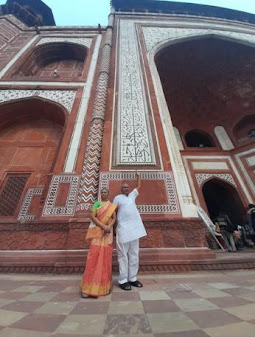Date - 16 November 2021
Dr. Ram Bajaj
& his 40 members team at Taj Mahal on 9, 10 & 11th November
2021 and their conclusion on the final various findings.
1.
Researcher
Dr.Bajaj explaining the reasons & causes of damages of two minarets of
royal gate. The shape of Royal Gate creates coanda effect (pressure difference)
between the front portion of Royal Gate & the back portion of the two
minarets (12 ft long pillars) on dt.12 April 2018. The storm was having the
speed of 130KMH.
2.
Effect of
water leakage on the inside portion of one of the main tomb entrance. Here the
marble slabs turn yellowish because of the chemical reactions. Researcher
indicating the yellowish portion – in front of Masjid side portion of Taj
Mahal.
3. Effect of Air quality on Taj on dt.9, 10 & 11 November 2021. An aerosol is a suspension of fine solid particles or liquid droplets in the air of Agra – Taj Mahal. Aerosols can be natural or anthropogenic. Examples of natural aerosols are fog or mist, dust, forest exudates in Agra city. Anthropogenic aerosols are particulate air pollutants and smoke.
Average:
|
PM2.5 |
– |
148 µg/m2 |
|
PM10 |
– |
204 µg/m2 |
|
NO2 |
– |
35.6 µg/m2 |
|
CO |
– |
1380 µg/m2 |
|
|
|
|
|
Temperature |
– |
17OC to 29OC |
|
Humidity |
– |
40% |
|
Wind |
– |
2.6 km/h |
|
Pressure |
– |
1013 mb |
4. The effect of wave length of light changes, the different colour with the amount of AQI & aerosol in the air. Researcher – Dr.Bajaj explaining the light rays (sun) effects on Taj Mahal at different angles of refraction to his team members.
5. Dr.Bajaj & his 40 member team – upstaring the Taj Mahal.
6.
Dr.Bajaj
explaining the effect of Yamuna River on its marble & red stone, railing to
his team members which felt down on 30 May 2020. The speed of storm 130kmph
creates the pressure difference – which causes to breakdown the railing. Bernoulli’s
effect.
7. Dr.Ram Bajaj & his team – inspecting the S.W minarets – which is supposed to be settled by more than 9.0 cm as per the various reports of ASI. However, Dr.Bajaj – has rejected the conclusion of settlement of minarets by the experts.
8. Dr.Bajaj is discussing with his team head – at Oberoi Amarvilas Hotel at Agra.
9. Researcher Dr.Ram Bajaj discussing the Civil Engineering discoveries – with various groups of expert, historians, teachers & guides.
10.
Dr.Bajaj
coming out from the main mausoleum of Taj Mahal with his team.
11. Dr.Bajaj – analyzing the effect of moisture, dampness & leakage of water – inside the main mausoleum of its surroundings rooms and roof.



























"Very well researched" 👍👍
ReplyDeleteVery very effective and curious Result you have sir, many researchers must need to learn from you.
ReplyDeleteI and all member of team feel proud for having mentor like you.
शानदार विश्लेषण प्रस्तुत किया है सर व उनकी टीम ने ऐतहासिक तथ्यों को सही तरीके से प्रस्तुत कर आपने ज्ञानवर्धन किया है चूंकि हम दिशा में जा रहे थे
ReplyDeleteIt is a deeply researched set of inferences. You have explored almost all the segments of this marvellous 17th century wonder. I came across this blog of yours and enjoyed reading it thoroughly. Congratulations Sir for so apt observations.
ReplyDelete